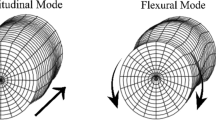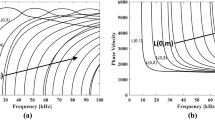Abstract
Guided wave (GW) has been used for many years in non-destructive testing (NDT). There are various ways to generate the guided wave, including impact or impulse either manually or using devices. Although the method of impact or impulse is considered to be simple and practical in guided wave generation, it produces waves with broadband frequencies, which often make analysis much more difficult. The frequency bandwidth produced by manual impacts is usually at the low end, and is therefore justified when dealing with one dimensional wave propagation assumption in low strain integrity testing of cylindrical structures. Under such assumption if the velocity is known accurately, NDTs can produce reasonably good results for the condition assessment of the structure. However, for guided wave propagation in timber pole-like structures, it is rather complicated as timber is an orthotropic material and wave propagation in an orthotropic medium exhibits different characteristics from that in isotropic medium. It is possible to obtain solutions for guided wave propagation in orthotropic media for cylindrical structures, even though the orthotropic material greatly complicates GW propagation. In this paper, timber has been considered as a transversely isotropic (i.e. simplified orthotropic) material and a comparative study of GW propagation in a timber pole is conducted considering isotropic and transversely isotropic modelling. Phase velocity, group velocity and attenuation are the main parameters for this comparative study. Moreover, traction-free situation and embedded geotechnical condition are also taken into consideration to evaluate the effect of boundary. Displacement profile, wave propagation pattern and power flow at particular frequency are utilized to determine different displacement components of longitudinal and flexural waves along and across the timber pole. Effect of temperature and moisture content (in terms of modulus of elasticity) in timber pole is also compared to show the variation in phase velocity.


























Similar content being viewed by others
References
Ahmad F (2001) Guided waves in a transversely isotropic cylinder immersed in a fluid. J Acoust Soc Am 109:886
Ando K, Ohta M (1999) Variability of fracture toughness by the crack tip position in an annual ring of coniferous wood. J Wood Sci 45:275–283
Auld BA (1990) Acoustic fields and waves in solids. Krieger, New York
Bodig J, Jayne B (1982) Mechanics of wood and wood composites. Krieger, New York
Brillouin L (1960) Wave propagation and group velocity. Academic Press, New York
Bucur V (2006) Acoustic of wood. Springer series in wood sciences. Springer, New York
Chree C, MAF (1889) The equation of an isotropic solid in polar and cylindrical coordinates, their solution and application. Cambridge Philosophical Society - Transactions, 14, 250
Chao HC (2002) An experimental model for non-destructive evaluation on pile foundations using guided wave approach. Ph. D. Dissertation, Northwestern University, Evanston, IL, USA
Dieulesaint E, Royer DJ (1980) Elastic waves in solids. Springer, New York
Dinwoodie JM (2000) Timber, its nature and behaviour. Taylor & Francis, London
Ellwood EL (1954) Properties of American beech in tension and compression perpendicular to the grain and their relation to drying. Yale University, New Haven
Finno R, Popovics JS, Hanifah AA, Kath WL, Chao HC, Hu YH (2001) Guided wave interpretation of surface reflection techniques for deep foundations. Ital Geotech J 35:76–91
Geo-Institute Deep Foundation Committee (2000) Nondestructive evaluation of drilled shafts. J Geotech Geoenviron Eng 126:92–95
Gerhards CC (1982) Effect of moisture content and temperature on the mechanical properties of wood: an analysis of immediate effects. Wood Fiber Sci 14:4–36
Graff KF (1975) Wave motion in elastic solids. Dover, New York
Green DW, Winandy JE, Kretschmann DE (1999) Mechanical properties of wood. Wood handbook: wood as an engineering material. US Department of Agriculture, Forest Service, Forest Products Laboratory, Madison, Report FPL-GTR, 113
Hanhijiirvi A (2000) Advances in the knowledge of the influence of moisture changes on the long-term mechanical performance of timber structures. Mater Struct 33:43–49
Hanifah AA (1999) A theoretical evaluation of guided waves in deep foundations. Ph. D. Dissertation, Northwestern University, Evanston, IL, USA
Honarvar F, Enjilela E, Sinclair AN, Mirnezami SA (2007) Wave propagation in transversely isotropic cylinders. Int J Solids Struct 44:5236–5246
Lenth C, Sargent R (2004) Investigating the influence of moisture content and temperature on the tensile stiffness of radiata pine In: Proceedings of 3rd international conference of the European society for wood mechanics. UTAD, Portugal
Lynch J (2007) Experimental verification of concrete piles subjected to flexural guided waves. Ph.D. Dissertation, Northwestern University, Evanston, IL, USA
Marzani A, Viola E, Bartoli I, Lanza Di Scalea F, Rizzo P (2008) A semi-analytical finite element formulation for modeling stress wave propagation in axisymmetric damped waveguides. J Sound Vib 318:488–505
Mascia NT, Cramer SM (2009) On the effect of the number of annual growth rings, specific gravity and temperature on redwood elastic modulus. Maderas Ciencia y tecnol 11:47–60
Meitzler AH (1965) Backward wave transmission of stress pulses in elastic cylinders and plates. J Acoust Soc Am 38:835
Nagy PB (1995) Longitudinal guided wave propagation in a transversely isotropic rod immersed in fluid. J Acoust Soc Am 98:454
Oliver A, Civil UOT, Dept ME (1991) A Model of the Behaviour of Wood as it Dries:(with Special Reference to Eucalypt Materials), Civil & Mechanical Engineering Dept., University of Tasmania, Report CM91-1
Palka L (1973) Predicting the effect of specific gravity, moisture content, temperature and strain rate on the elastic properties of softwoods. Wood Sci Technol 7:127–141
Pavlakovic B, Lowe M (2003) Disperse software manual Version 2.0.16B. Imperial College, London
Pochhammer L (1876) über die fortplanzungsgeschwindigkeiten schwingungen in einem unbegrentzten isotropen kreiscylinder. für die reine angewandte Mathematik 81:324–336
Popovics JS (1994) Some theoretical and experimental aspects of the use of guided waves for the nondestructive evaluation of concrete. Ph. D dissertation, Pennsylvania State University, US
Rose J (1999) Ultrasonic waves in solid media. Cambridge University Press, Cambridge
Ross RJ, Pellerin RF, Volny N, Salsig WW, Falk RH (1999) Inspection of timber bridges using stress wave timing nondestructive evaluation tools. US Department of Agriculture, Forest Service, Forest Products Laboratory, Madison, Report FPL-GTR, 114
Tallavo F, Cascante G, Pandey MD (2011) Estimation of the probability distribution of wave velocity in wood poles. J Mater Civ Eng 23:1272–1280
Towfighi S, Ehsani M (2002) Elastic wave propagation in circumferential direction in anisotropic cylindrical curved plates. J Appl Mech 69:283
Tsai Y (1991) Longitudinal motion of a thick transversely isotropic hollow cylinder. J Press Vessel Technol 113:585
Tsai Y, Liu S, Light G (1990) Cylindrically guided waves in a transversely isotropic shaft. Review of progress in quantitative nondestructive testing, 9, Plenum Press, New York
Wang H (2004) Theoretical evaluation of embedded plate-like and solid cylindrical concrete structures with guided waves. Ph. D. Dissertation, Northwestern University, Evanston, IL, USA
Wu Q, Milota MR (1995) Rheological behavior of Douglas-fir perpendicular to the grain at elevated temperatures. Wood Fiber Sci 27:285–295
Zemanek J Jr (1962) An experimental and theoretical investigation of elastic wave propagation in a cylinder. Ph.D Dissertation, University of California, Los Angeles, USA
Author information
Authors and Affiliations
Corresponding author
Rights and permissions
About this article
Cite this article
Subhani, M., Li, J. & Samali, B. A comparative study of guided wave propagation in timber poles with isotropic and transversely isotropic material models. J Civil Struct Health Monit 3, 65–79 (2013). https://doi.org/10.1007/s13349-012-0032-1
Received:
Revised:
Accepted:
Published:
Issue Date:
DOI: https://doi.org/10.1007/s13349-012-0032-1




